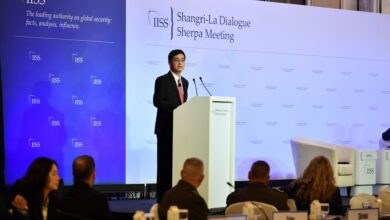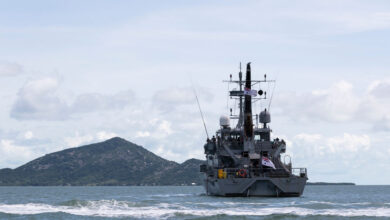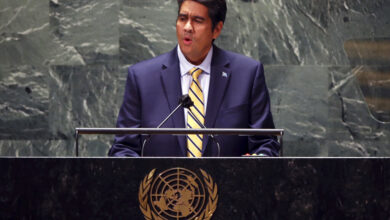PRC expands foothold in Bangladesh, raising new questions

Suspicions about the People’s Republic of China’s (PRC’s) renewed interest in Bangladesh infrastructure projects are increasing amid the COVID-19 pandemic and Rohingya refugee crisis.
Specifically, PRC involvement in a U.S. $184 million runway extension in Cox’s Bazar to enable the world’s largest aircraft, including military ones, to land and refuel is renewing concerns, analysts said.
“The government is funding the project to extend the existing runway. We have tasked the two Chinese companies to convert the domestic airport into an international one,” Mahbub Ali, Bangladesh’s civil aviation minister, told BenarNews in August 2021.
To make the runway the longest in Bangladesh, officials contracted in February 2021 with two PRC-owned firms, China Civil Engineering Construction Corp. (CCECC) and Changjiang Yichang Waterway Engineering Bureau, to extend it about 1,700 feet (518 meters) through an extensive dredging project in the Bay of Bengal. (Pictured: A satellite image taken January 11, 2021, shows Cox’s Bazar Airport in Bangladesh.)
CCECC, which has airport, dredging and marine works contracts in 105 countries, is positioned to become the second-largest dredging company in Bangladesh and is also engaged in a rail construction project to connect the southeastern city of Dohazari to Cox’s Bazar, according to the Daily Sun website.
Although the runway extension has been promoted as a boon for tourism, the PRC likely eyes the airport for military uses, given that Cox’s Bazar is not a tourist destination, analysts said.
Flights bound for Southeast Asia and the Pacific region could refuel at the airport, which lies along the route from the Middle East, Faruk Khan, a retired colonel and former Bangladeshi civil aviation minister, told BenarNews.
Under its One Belt, One Road (OBOR) infrastructure scheme, the PRC has long desired to connect its Yunnan province to South Asia by constructing a road from Kunming through Cox’s Bazar to Kolkata, India. The route, known as the K-to-K, would also enable Bangladesh to connect to the China-Pakistan Economic Corridor.
India and other nations have been monitoring such aggressive maneuvers by the PRC. India is especially concerned with the PRC’s jockeying for strategic positioning around the Indian Ocean. Under OBOR, the PRC has already funded the development of Bangladesh’s Chittagong port and Pakistan’s Gwadar port, where India fears China could station submarines.
OBOR projects in South and Southeast Asia, in particular, have often proved to be financially unsustainable and have hurt political relations.
Perhaps the most high-profile debacle remains Sri Lanka’s Hambantota port, which the Sri Lanka government was forced to turn over to the PRC in December 2017. Various OBOR projects have burdened Sri Lanka and other nearby Indo-Pacific countries such as Myanmar (Burma)and Nepal with potentially unpayable debt, placing them at risk for loss of sovereignty and increased PRC interference in their affairs.
Although many countries in the region and worldwide have grown more cautious of accepting PRC funding, especially in the form of concessional loans, the economic downturn linked to the COVID-19 pandemic has pressured nations to reconsider Chinese enticements.
In recent years, Bangladesh has turned over several projects to Japan, largely in response to reports of PRC difficulties, including corruption, performance delays, funding shortfalls and national security controversies. In January 2020, citing environmental concerns, Bangladesh scrapped plans to build a deep seaport in Cox’s Bazar with the PRC at Sonadia Island and proceeded with the Japanese-backed project 25 kilometers away in Matarbari, the Dhaka Tribune newspaper reported.
The PRC seems to be capitalizing on the pandemic and Rohingya refugee situation to strengthen relations with the Bangladesh and Myanmar governments, while doing little to assist citizens at risk. In February 2021, for example, the PRC blocked a United Nations Security Council statement condemning the military coup in Myanmar, the BBC reported.
Moreover, the PRC has contributed relatively little to assist the nearly 900,000 refugees in Bangladesh who have fled violence in Myanmar’s Rakhine State since 2017. Most of the refugees live in roughly 34 camps in the Cox’s Bazar District.
The United States remains the largest provider of humanitarian aid to alleviate the situation, followed by the United Kingdom, Australia, the European Commission, Japan, Canada, the Qatar Thani Foundation, Germany, Saudi Arabia, the United Arab Emirates, New Zealand, Norway and Turkey, which have also made generous contributions.
In 2021, U.S. Secretary of State Antony Blinken announced an additional U.S. $155 million in assistance. “As the leading contributor of assistance in response to the Rohingya refugee crisis, the United States is helping to support the victims of atrocities and other vulnerable people in need,” Blinken said in a May statement. “With this new funding, our total humanitarian aid for those affected by the crisis in Burma, Bangladesh, and elsewhere in the region since the brutal violence by the Burmese military in August 2017 is more than [U.S.] $1.3 billion, including more than [U.S.] $1.1 billion for programs inside Bangladesh.”
IMAGE CREDIT: DIGITAL GLOBE




